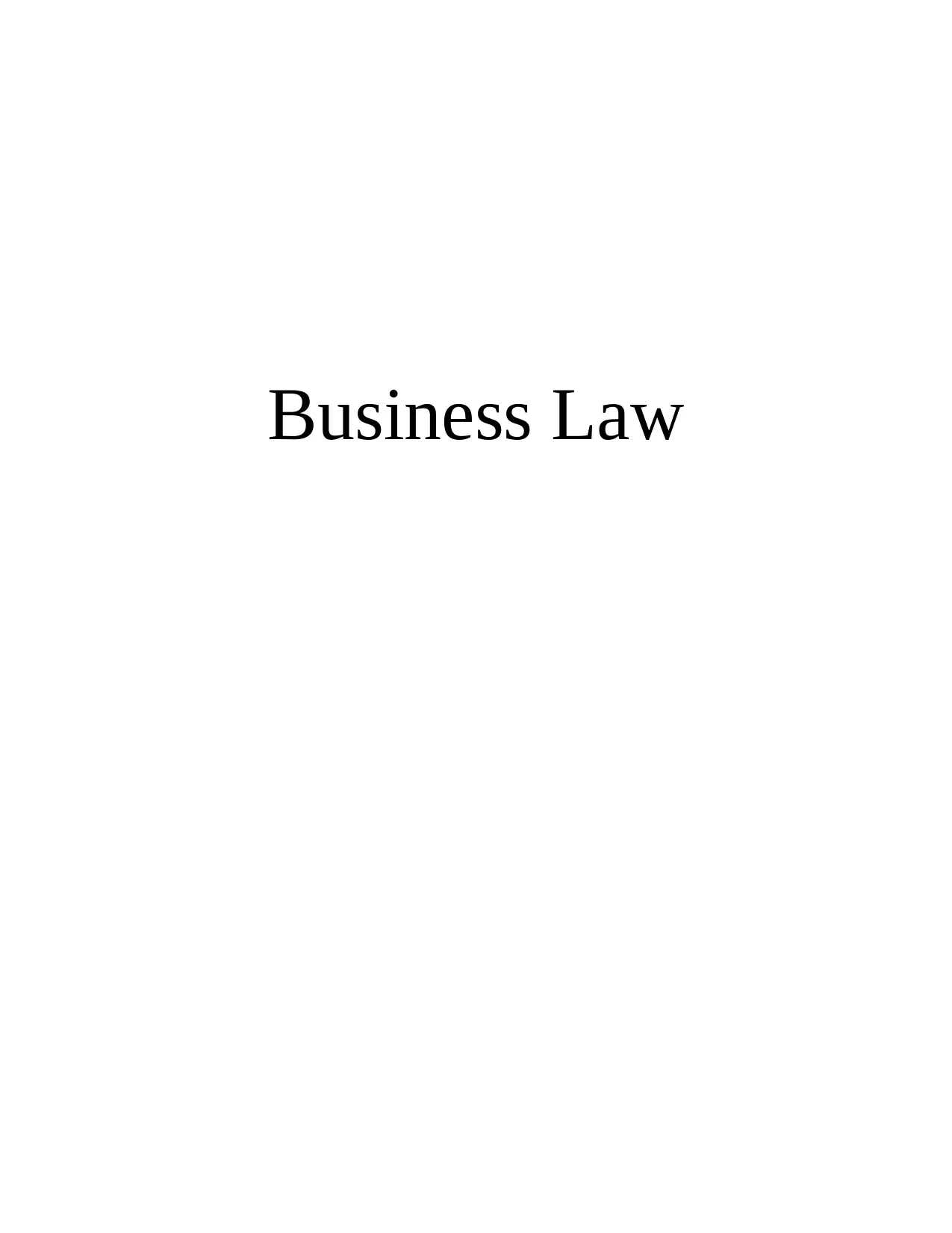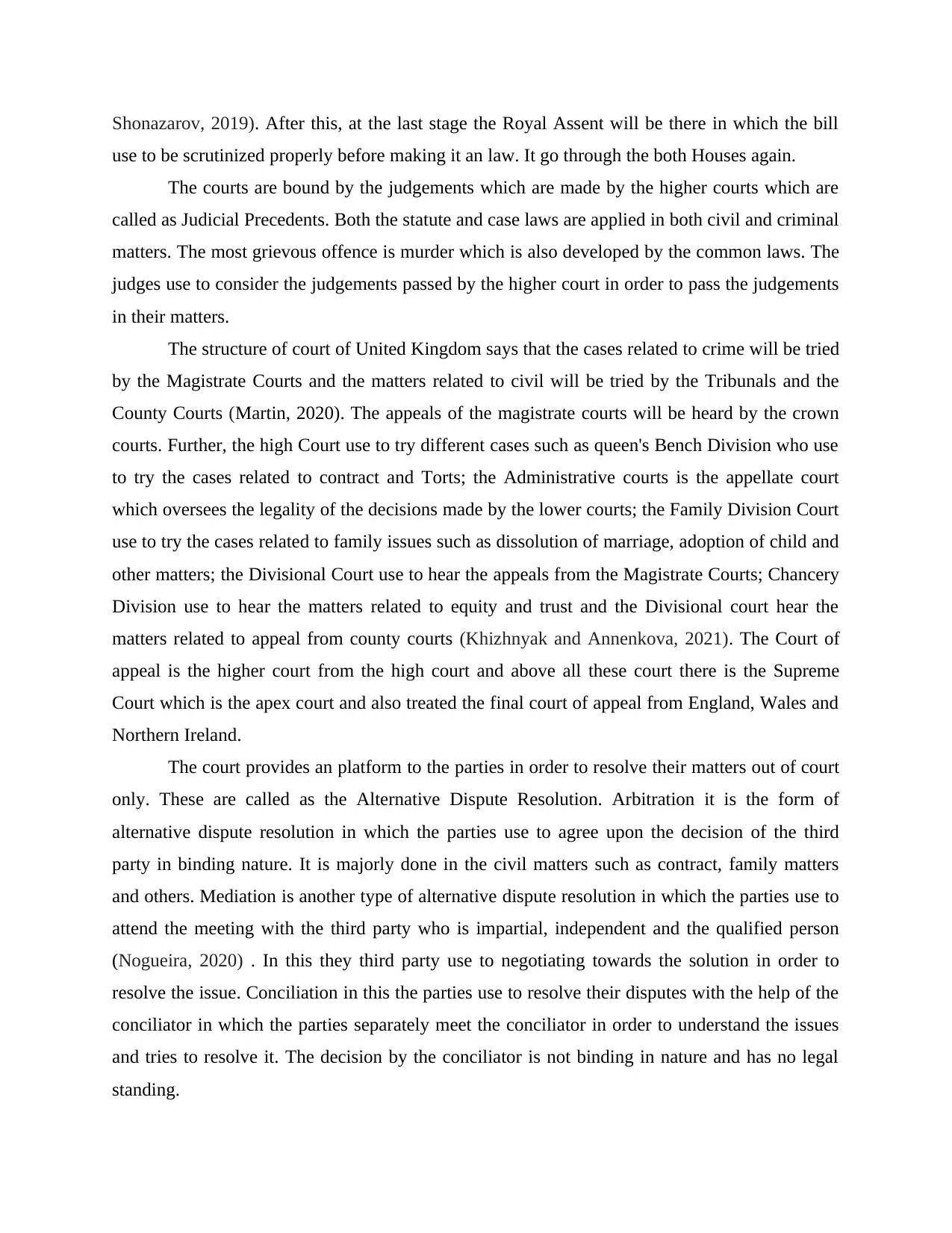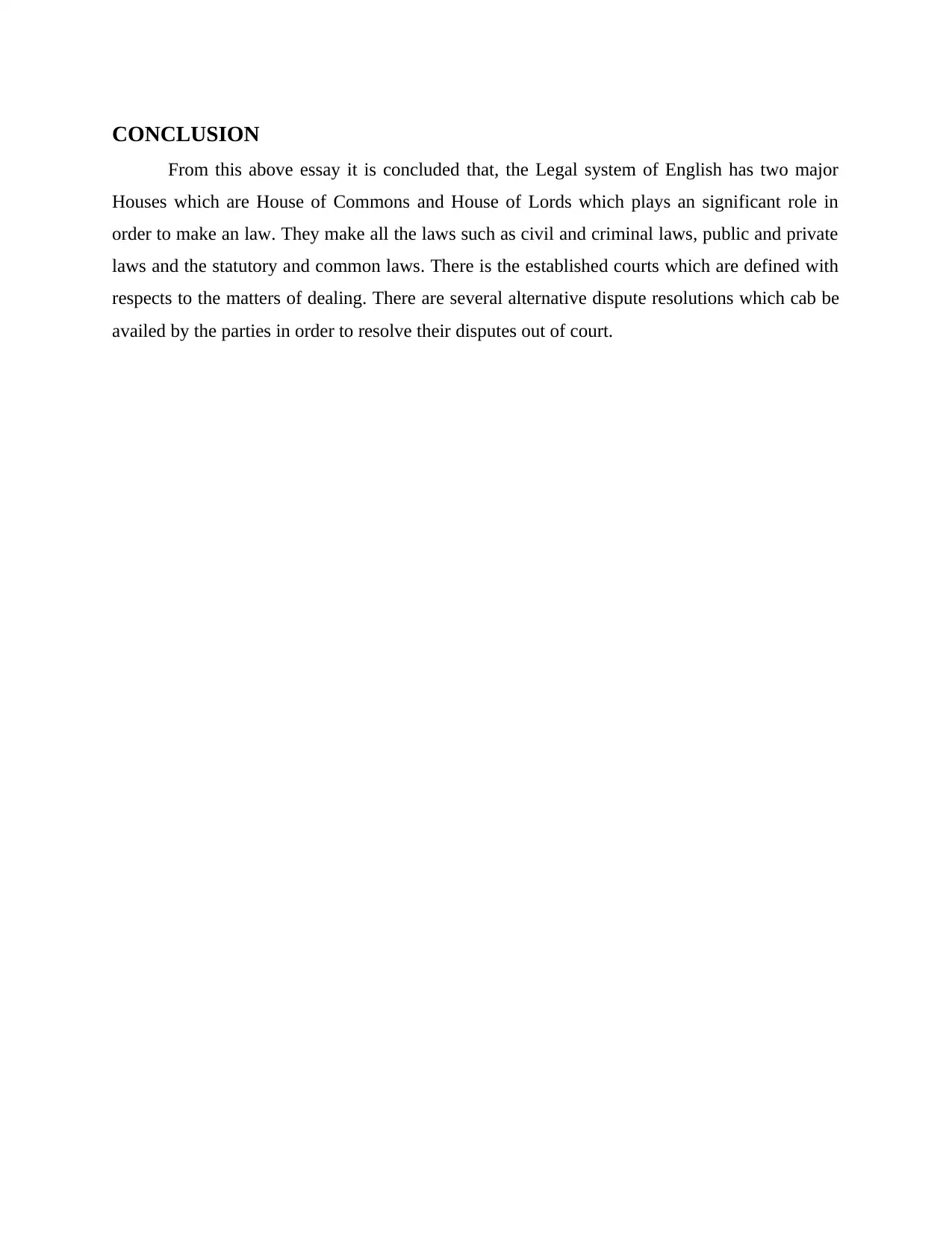Business Law Essay: Statute, Case Law, and Court System Overview
VerifiedAdded on 2022/12/14
|6
|1384
|202
Essay
AI Summary
This essay provides a comprehensive overview of business law, focusing on statute and case law within the English legal system. It examines the process of how statutes are passed, the application of both statute and case law in civil and criminal matters, and the structure of the UK court system, including the roles of different courts such as Magistrate Courts, County Courts, High Courts, and the Supreme Court. The essay also explores alternative dispute resolution (ADR) methods, including arbitration, mediation, and conciliation. The conclusion summarizes the key aspects of the English legal system, emphasizing the roles of the Houses of Parliament and the significance of various court structures and ADR mechanisms in resolving legal disputes. The essay is well-structured, with clear definitions, explanations, and references to support its arguments.

Business Law
Paraphrase This Document
Need a fresh take? Get an instant paraphrase of this document with our AI Paraphraser

Table of Contents
INTRODUCTION ..........................................................................................................................3
MAIN BODY ..................................................................................................................................3
CONCLUSION ...............................................................................................................................5
REFERENCES................................................................................................................................6
INTRODUCTION ..........................................................................................................................3
MAIN BODY ..................................................................................................................................3
CONCLUSION ...............................................................................................................................5
REFERENCES................................................................................................................................6

INTRODUCTION
Law is the source which helps in regulating the behaviour of the people. It is the art of
justice which is made by the legislatures, executives and judges. The common law legal system
of the England and Wales is the English law which mainly deals with the criminal and civil laws
(Buhrer, 2019). This report is being discussed about the Statute law and Case law. The manner
in which the statute can be passed and how these are applied in the criminal and civil cases. The
different courts deals with the different cases and the ways where parties can go for the out of
court settlement.
MAIN BODY
Statute law is the rules and principles which are made in the statutes. These are the laws
which are passed by the legislatures. It can be originated from the national, state legislatures or
the local municipalities. It can be codified or uncodified. The law which is made during the
judgement is called as the common law this can be derived from the customs and precedents
(Coker, 2018). These laws can be superseded or replaced by the legislation.
The law can be passed on the bases of the established procedure. The initiative is taken
by the legislation and they proposed the bill in the Parliament which is debated in both the
Houses through the set stages which is as follows: at the first stage the bill will be reading out the
title and decide the date of second reading and the members give an opportunity to debate about
the matter of the bill at the second reading (Yip, 2021). At the second reading the members use
to give their opinions with respect to the specific points. When the bill is supported by the
majority then it will be proceeds on the next stage. At the committee stage the bill is properly
scrutinised and the amendments can be taken place. On this stage the members can prove their
opinions with the help of an evidence and upon the satisfaction the bill can be re-drafted. On the
next stage the MPs got an opportunity to consider the changes which are made in the bill. They
are also allowed to make further amendments and after this stage the third reading also takes
place. The Third reading is the done by the House of Commons they use to read the bill without
making any changes into it. Then they vote for the bill and then on the bases of the majority the
bill is being passed by the House of lords. After this, at the stage of consideration the members
can propose the amendments in the bill and then the bill will be sent back to the lower house of it
consideration and then the same process will be consider (Eskaraeva, Torebaeva and
Law is the source which helps in regulating the behaviour of the people. It is the art of
justice which is made by the legislatures, executives and judges. The common law legal system
of the England and Wales is the English law which mainly deals with the criminal and civil laws
(Buhrer, 2019). This report is being discussed about the Statute law and Case law. The manner
in which the statute can be passed and how these are applied in the criminal and civil cases. The
different courts deals with the different cases and the ways where parties can go for the out of
court settlement.
MAIN BODY
Statute law is the rules and principles which are made in the statutes. These are the laws
which are passed by the legislatures. It can be originated from the national, state legislatures or
the local municipalities. It can be codified or uncodified. The law which is made during the
judgement is called as the common law this can be derived from the customs and precedents
(Coker, 2018). These laws can be superseded or replaced by the legislation.
The law can be passed on the bases of the established procedure. The initiative is taken
by the legislation and they proposed the bill in the Parliament which is debated in both the
Houses through the set stages which is as follows: at the first stage the bill will be reading out the
title and decide the date of second reading and the members give an opportunity to debate about
the matter of the bill at the second reading (Yip, 2021). At the second reading the members use
to give their opinions with respect to the specific points. When the bill is supported by the
majority then it will be proceeds on the next stage. At the committee stage the bill is properly
scrutinised and the amendments can be taken place. On this stage the members can prove their
opinions with the help of an evidence and upon the satisfaction the bill can be re-drafted. On the
next stage the MPs got an opportunity to consider the changes which are made in the bill. They
are also allowed to make further amendments and after this stage the third reading also takes
place. The Third reading is the done by the House of Commons they use to read the bill without
making any changes into it. Then they vote for the bill and then on the bases of the majority the
bill is being passed by the House of lords. After this, at the stage of consideration the members
can propose the amendments in the bill and then the bill will be sent back to the lower house of it
consideration and then the same process will be consider (Eskaraeva, Torebaeva and
⊘ This is a preview!⊘
Do you want full access?
Subscribe today to unlock all pages.

Trusted by 1+ million students worldwide

Shonazarov, 2019). After this, at the last stage the Royal Assent will be there in which the bill
use to be scrutinized properly before making it an law. It go through the both Houses again.
The courts are bound by the judgements which are made by the higher courts which are
called as Judicial Precedents. Both the statute and case laws are applied in both civil and criminal
matters. The most grievous offence is murder which is also developed by the common laws. The
judges use to consider the judgements passed by the higher court in order to pass the judgements
in their matters.
The structure of court of United Kingdom says that the cases related to crime will be tried
by the Magistrate Courts and the matters related to civil will be tried by the Tribunals and the
County Courts (Martin, 2020). The appeals of the magistrate courts will be heard by the crown
courts. Further, the high Court use to try different cases such as queen's Bench Division who use
to try the cases related to contract and Torts; the Administrative courts is the appellate court
which oversees the legality of the decisions made by the lower courts; the Family Division Court
use to try the cases related to family issues such as dissolution of marriage, adoption of child and
other matters; the Divisional Court use to hear the appeals from the Magistrate Courts; Chancery
Division use to hear the matters related to equity and trust and the Divisional court hear the
matters related to appeal from county courts (Khizhnyak and Annenkova, 2021). The Court of
appeal is the higher court from the high court and above all these court there is the Supreme
Court which is the apex court and also treated the final court of appeal from England, Wales and
Northern Ireland.
The court provides an platform to the parties in order to resolve their matters out of court
only. These are called as the Alternative Dispute Resolution. Arbitration it is the form of
alternative dispute resolution in which the parties use to agree upon the decision of the third
party in binding nature. It is majorly done in the civil matters such as contract, family matters
and others. Mediation is another type of alternative dispute resolution in which the parties use to
attend the meeting with the third party who is impartial, independent and the qualified person
(Nogueira, 2020) . In this they third party use to negotiating towards the solution in order to
resolve the issue. Conciliation in this the parties use to resolve their disputes with the help of the
conciliator in which the parties separately meet the conciliator in order to understand the issues
and tries to resolve it. The decision by the conciliator is not binding in nature and has no legal
standing.
use to be scrutinized properly before making it an law. It go through the both Houses again.
The courts are bound by the judgements which are made by the higher courts which are
called as Judicial Precedents. Both the statute and case laws are applied in both civil and criminal
matters. The most grievous offence is murder which is also developed by the common laws. The
judges use to consider the judgements passed by the higher court in order to pass the judgements
in their matters.
The structure of court of United Kingdom says that the cases related to crime will be tried
by the Magistrate Courts and the matters related to civil will be tried by the Tribunals and the
County Courts (Martin, 2020). The appeals of the magistrate courts will be heard by the crown
courts. Further, the high Court use to try different cases such as queen's Bench Division who use
to try the cases related to contract and Torts; the Administrative courts is the appellate court
which oversees the legality of the decisions made by the lower courts; the Family Division Court
use to try the cases related to family issues such as dissolution of marriage, adoption of child and
other matters; the Divisional Court use to hear the appeals from the Magistrate Courts; Chancery
Division use to hear the matters related to equity and trust and the Divisional court hear the
matters related to appeal from county courts (Khizhnyak and Annenkova, 2021). The Court of
appeal is the higher court from the high court and above all these court there is the Supreme
Court which is the apex court and also treated the final court of appeal from England, Wales and
Northern Ireland.
The court provides an platform to the parties in order to resolve their matters out of court
only. These are called as the Alternative Dispute Resolution. Arbitration it is the form of
alternative dispute resolution in which the parties use to agree upon the decision of the third
party in binding nature. It is majorly done in the civil matters such as contract, family matters
and others. Mediation is another type of alternative dispute resolution in which the parties use to
attend the meeting with the third party who is impartial, independent and the qualified person
(Nogueira, 2020) . In this they third party use to negotiating towards the solution in order to
resolve the issue. Conciliation in this the parties use to resolve their disputes with the help of the
conciliator in which the parties separately meet the conciliator in order to understand the issues
and tries to resolve it. The decision by the conciliator is not binding in nature and has no legal
standing.
Paraphrase This Document
Need a fresh take? Get an instant paraphrase of this document with our AI Paraphraser

CONCLUSION
From this above essay it is concluded that, the Legal system of English has two major
Houses which are House of Commons and House of Lords which plays an significant role in
order to make an law. They make all the laws such as civil and criminal laws, public and private
laws and the statutory and common laws. There is the established courts which are defined with
respects to the matters of dealing. There are several alternative dispute resolutions which cab be
availed by the parties in order to resolve their disputes out of court.
From this above essay it is concluded that, the Legal system of English has two major
Houses which are House of Commons and House of Lords which plays an significant role in
order to make an law. They make all the laws such as civil and criminal laws, public and private
laws and the statutory and common laws. There is the established courts which are defined with
respects to the matters of dealing. There are several alternative dispute resolutions which cab be
availed by the parties in order to resolve their disputes out of court.

REFERENCES
Books and Journals
Buhrer, E., 2019. “If in Other Respects He Appears to Be Effectively Human”: Defining
Monstrosity in Medieval English Law. In Monstrosity, Disability, and the Posthuman in
the Medieval and Early Modern World (pp. 63-83). Palgrave Macmillan, Cham.
Coker, C., 2018. Gendered spheres: theorizing space in the English printing house. The
Seventeenth Century, 33(3), pp.323-336.
Eskaraeva, S.A., Torebaeva, F.K. and Shonazarov, I.M., 2019. PROBLEMS OF TEACHING
PROFESSIONALLY-ORIENTED ENGLISH AT HIGHER EDUCATIONAL
ESTABLISHMENTS. Мировая наука, (5), pp.40-42.
Khizhnyak, S.P. and Annenkova, V.G., 2021. The Variety of Language Signs in Legal
Terminology: Linguistic and Extra-Linguistic Background. International Journal for
the Semiotics of Law-Revue internationale de Sémiotique juridique, pp.1-18.
Martin, I.P., 2020. Philippine English. The Handbook of Asian Englishes, pp.479-500.
Nogueira, G.G., 2020. The Protection of Public Interest in Contract-Based Arbitration with
Public Entities: A Comparative Analysis of the English and Brazilian Legal
Systems. Arbitration: The International Journal of Arbitration, Mediation and Dispute
Management, 86(2).
Yip, M., 2021. Comparing family property disputes in English and Singapore law:‘context is
everything’. Legal Studies, pp.1-19.
Books and Journals
Buhrer, E., 2019. “If in Other Respects He Appears to Be Effectively Human”: Defining
Monstrosity in Medieval English Law. In Monstrosity, Disability, and the Posthuman in
the Medieval and Early Modern World (pp. 63-83). Palgrave Macmillan, Cham.
Coker, C., 2018. Gendered spheres: theorizing space in the English printing house. The
Seventeenth Century, 33(3), pp.323-336.
Eskaraeva, S.A., Torebaeva, F.K. and Shonazarov, I.M., 2019. PROBLEMS OF TEACHING
PROFESSIONALLY-ORIENTED ENGLISH AT HIGHER EDUCATIONAL
ESTABLISHMENTS. Мировая наука, (5), pp.40-42.
Khizhnyak, S.P. and Annenkova, V.G., 2021. The Variety of Language Signs in Legal
Terminology: Linguistic and Extra-Linguistic Background. International Journal for
the Semiotics of Law-Revue internationale de Sémiotique juridique, pp.1-18.
Martin, I.P., 2020. Philippine English. The Handbook of Asian Englishes, pp.479-500.
Nogueira, G.G., 2020. The Protection of Public Interest in Contract-Based Arbitration with
Public Entities: A Comparative Analysis of the English and Brazilian Legal
Systems. Arbitration: The International Journal of Arbitration, Mediation and Dispute
Management, 86(2).
Yip, M., 2021. Comparing family property disputes in English and Singapore law:‘context is
everything’. Legal Studies, pp.1-19.
⊘ This is a preview!⊘
Do you want full access?
Subscribe today to unlock all pages.

Trusted by 1+ million students worldwide
1 out of 6
Related Documents
Your All-in-One AI-Powered Toolkit for Academic Success.
+13062052269
info@desklib.com
Available 24*7 on WhatsApp / Email
![[object Object]](/_next/static/media/star-bottom.7253800d.svg)
Unlock your academic potential
Copyright © 2020–2025 A2Z Services. All Rights Reserved. Developed and managed by ZUCOL.





